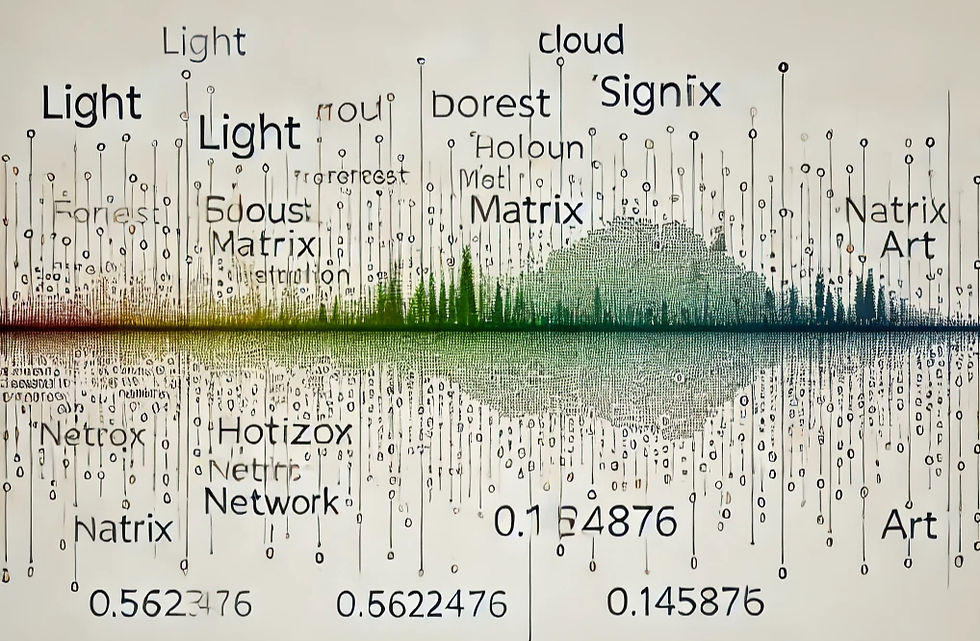Vectorization: What is it & Why is it Important?
- Chattie Blogs
- Sep 4, 2024
- 4 min read

Vectorization
In the rapidly advancing world of artificial intelligence (AI) and machine learning (ML), the term vectorization has become a critical concept. While it may sound technical, understanding vectorization and why it’s important can be transformative for businesses that harness AI technologies to drive innovation and efficiency.
What is Vectorization?
At its core, vectorization is the process of converting data into a numerical format that can be understood and processed by machines—most commonly into a vector. A vector is essentially an array of numbers, which allows computers to perform calculations quickly and efficiently. In machine learning, these vectors represent various forms of data such as words, images, or customer behaviours.
Take text data, for example. A machine cannot inherently understand words. However, through vectorization, words can be transformed into numerical representations, known as "word embeddings", enabling algorithms to perform operations such as pattern recognition, similarity detection, and predictions. This is especially important in Natural Language Processing (NLP).
Why is Vectorization Important?
Without vectorization, machines would struggle to interpret the raw, unstructured data (such as natural language or images) that is so prevalent in today’s digital age. Here’s why it matters:
Efficiency: Vectorization speeds up the process of computation. Whether it’s a search engine sorting through massive databases or AI models learning from huge datasets, vectorized data can be processed much faster, enabling real-time decision-making.
Accuracy: By converting complex data into precise numerical representations, algorithms can identify intricate patterns and correlations that would otherwise remain undetected, resulting in more accurate predictions.
Scalability: As datasets grow exponentially, vectorization enables systems to scale and handle larger volumes of data without performance bottlenecks.
Interoperability: Vectorization makes it possible to compare different types of data (text, images, etc.) within the same framework. For instance, vectors can represent both a product image and its description, allowing the system to find matches between the two.
Innovation: By converting data into machine-readable formats, businesses can unlock new possibilities for innovation. Whether that's understanding customer queries more effectively, or an AI model predicting future trends, vectorization forms the foundation of many breakthrough applications.
Real-World Examples of Vectorization in Action
A few real-world examples where vectorization is playing a crucial role:
Google Search: One of the most ubiquitous uses of vectorization is in search engines. Google's algorithms rely heavily on vectorization techniques and more advanced word embeddings to rank and retrieve relevant web pages based on search queries. Vectorization makes it possible for Google to understand the context of words and deliver precise results in milliseconds.
Recommendation Systems: Companies like Netflix and Spotify use vectorization to deliver personalised recommendations. By converting user interactions (likes, views, clicks) into vectors, these companies can analyse behaviours at scale and identify patterns that help predict which content a user is likely to engage with next.
Image Recognition: In industries like healthcare, image recognition is driven by vectorization. For instance, AI models used for diagnosing medical images vectorise each image, allowing for rapid and accurate analysis of conditions such as tumours or fractures.
Voice Assistants: Virtual assistants like Amazon Alexa and Apple’s Siri use vectorization to understand spoken language. By breaking down speech into numerical vectors, these systems can interpret commands, detect sentiment, and interact with users in natural, conversational ways.
E-commerce: Vectorization has significantly improved product search on e-commerce platforms. When a customer uploads an image to search for a product, machine learning algorithms vectorise both the image and textual data of product listings, offering the best matches based on visual and contextual similarities.
Value Drivers of Vectorization
As we’ve seen, vectorization is not just a technical process; it’s a fundamental enabler of advanced AI solutions. Here are the top five value drivers that make vectorization indispensable to modern businesses:
Improved Performance: Vectorized data enables algorithms to run faster and more efficiently. In AI applications where real-time processing is essential, vectorization ensures that massive datasets can be handled without compromising on speed.
Increased Accuracy: By converting complex, unstructured data into numerical formats, vectorization improves the precision of machine learning models. More accurate models lead to better decisions, optimising outcomes in fields like marketing, finance, and healthcare.
Cost Reduction: As machine learning models scale, efficiency becomes critical. Vectorization reduces the computational overhead, allowing businesses to reduce their cloud infrastructure costs or to get more out of existing resources.
Enhanced Customer Experience: Whether it’s providing better search results, personalising recommendations, or improving chat interactions, vectorization underpins many customer-facing AI solutions that enhance user experience and engagement.
Business Scalability: As businesses collect more and more data, vectorization ensures that they can manage and analyse these increasing volumes efficiently. This scalability makes it easier for companies to grow without facing technical limitations.
In Summary
Vectorization is more than just a technical process; it’s a foundational element that drives innovation, efficiency, and accuracy across a wide range of industries. It is a fundamental part of what we do at Chattie to enable bespoke, accurate and relevant content at lightning-fast speeds.
We see Vectorization playing an important role at many of today's most recognisable brands, from improving search results in Google to enabling personalised recommendations on Netflix.
For businesses seeking to leverage AI technologies, understanding and implementing vectorization can be a game-changer. It enables companies to harness their data effectively, leading to faster decision-making, better customer experiences, and new avenues for growth. As AI continues to evolve, the importance of vectorization will only increase, offering businesses the opportunity to stay ahead in an increasingly competitive landscape. If you'd like to learn more about vectorization or about our products and services, contact us at info@chattie.co.uk.





Comments